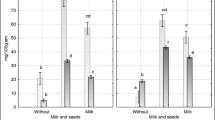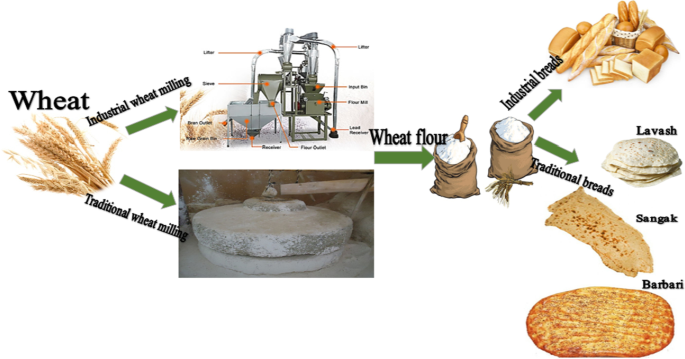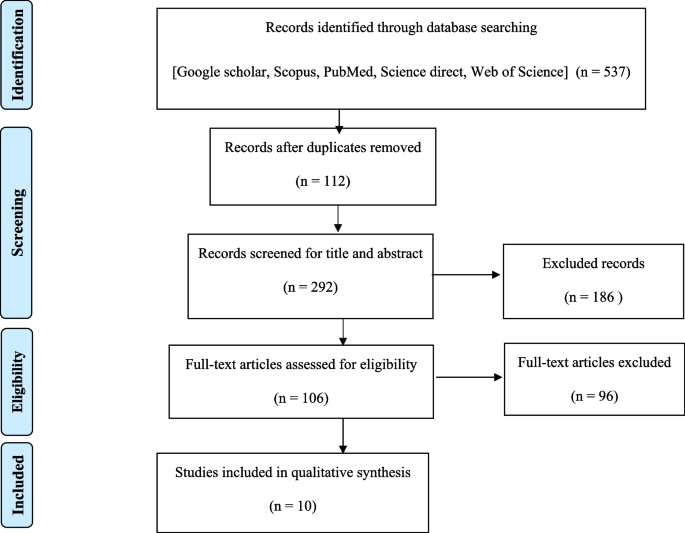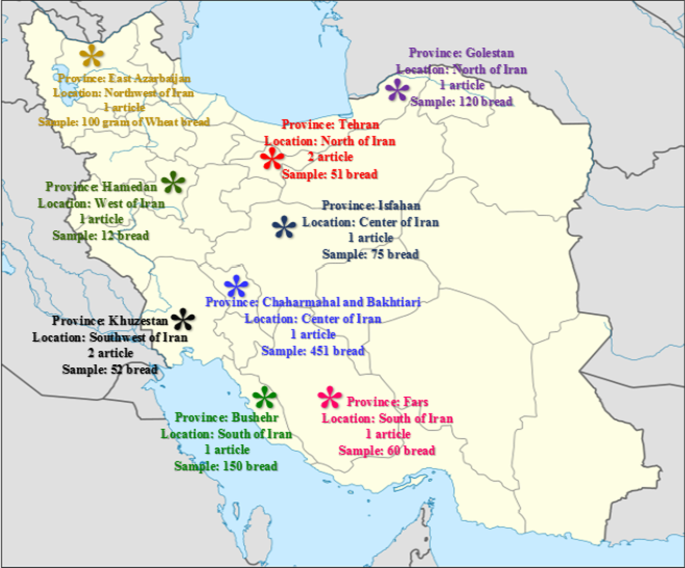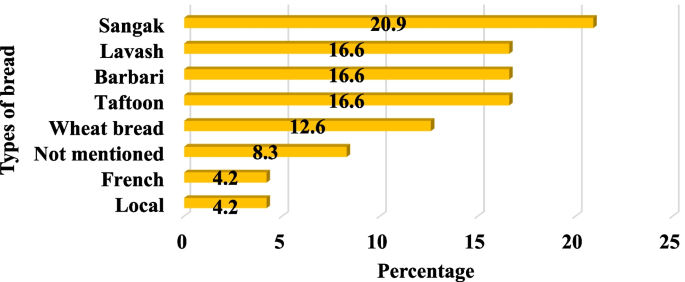Abstract
Background
A balanced and optimized amount of nutrients in bread, which is the main food in many countries, is necessary to maintain human health. Considering the importance of nutritional values of bread in the food basket of Iranian households, the purpose of this study was to determine the nutrients and their concentrations in breads consumed in Iran.
Methods
This systematic review study was performed to determine the types of nutrients in breads consumed in Iran by searching reputable international databases including Scopus and Google scholar, PubMed, Science direct, ISI (Web of Science). Data were collected according to inclusion and exclusion criteria and by searching for relevant keywords, emphasizing the types of nutrients in breads consumed in Iran. Qualitative data were collected using the standard PRISMA checklist (preferential reporting items for systematic reviews and meta-analysis). After verifying the quality of the articles, the information was entered into a checklist such as the name of the first author and year of publication of the research, type of study, number of samples, type of nutrition, type of bread and amount of nutrition measured.
Results
After reviewing the information and quality of articles, 10 articles were qualified for systematic review. The review of the articles showed that different breads were experimented, including: Sangak, Barbari, Taftoon, Lavash, French and local bread. The highest number of experimented bread samples was Sangak. Examination of the articles showed that 6 nutrients were experimented in different breads such as Fe, K, Mg, Ca, Cu and Zn. The highest number of experimented in breads was related to the amount of Zn (13 times) and Cu (10 times), respectively. The results of quality assessment of articles showed that most of the studies were of good quality. The results of articles on the amount of nutrients measured in different breads showed that only in two articles the amount of nutrients was reported to be desirable. In most articles, the amount of nutrients in breads was reported to be lower or higher than standard.
Conclusion
The results of this study showed that the concentration of nutrients in most articles was undesirable. It is suggested that optimal methods of enrichment of breads and flours be done with interdisciplinary cooperation between food hygiene, environmental health, nutrition, farmers and bakers. It is recommended that food hygiene and environmental health researchers investigate other nutrients (including phosphorus, selenium, manganese, boron and molybdenum) in breads and other staple foods used by people to constructive and practical measures to increase public health.
Similar content being viewed by others
Introduction
Cereals such as wheat, rice, corn and barley are the basis of human nutrition and life and provide 70% of people’s food [1, 2]. Bread contains a type of cereals called wheat, which is why bread is a staple food in developing countries, especially in Africa and Asia. Baking bread from farm to bakery has several steps (Fig. 1), and each of these steps must comply with the principles of hygiene and food quality because the steps of bread preparation affect the quality of bread. In general, there are three types of bread serial/dough sources worldwide, which are wheat bread (with gluten), bread without gluten and combined bread [3, 4].
Bread provides several nutrients such as sugar, protein, iron, calcium and a variety of vitamins [5]. An average daily intake of 300 g of bread can provide the nutrients needed by the body and create a desired nutritional status [6]. Bread can provide 1.2% of protein, 60% of thiamine and niacin, 40% of calcium and 80% of the daily iron needed by an adult [7, 8].
Deficiency of nutrients endangers human health. According to the World Health Organization, malnutrition due to nutrient deficiency is a major problem and affects more than two billion people worldwide [9]. The amount of nutrients (P, K, Se, Mg, Ca, B, MO, Cu, Zn, Mn) varies in food, including different bread samples, and each of the nutrients has a specific structure (Table 1).
Nutrients have different biological effects on the body. Iron is one of the nutrients which deficiency causes the most common nutritional problems. For example, iron deficiency anemia is the most common type of anemia in the world [20, 21]. Zn is another nutrient that is the second most abundant trace element in the body after iron and participates in the synthesis of brain enzymes [22]. The recommended amount of Zn for daily absorption is 60 mg [23]. Zn is contained in several enzymes including carbonic anhydrase, dehydrogenase, proteinase and peptidase, and Zn in wheat reduces the carbohydrate content of leaves and stems [24]. Zn deficiency causes diseases such as impaired physical development and the immune system, reduced ability to learn, increased risk of infection and cancer [25, 26]. Cu is another nutrient that is a vital component of the body. Cu is involved in the structure, function and activity of many enzymes, in the function and activity of catalase, peroxidase and glutathione in the body. Cu deficiency increases the sensitivity of lipoproteins to peroxidation [27,28,29]. Se is another nutrient that prevents toxin transmission from mother to fetus. Se is an antioxidant in the body. Scientists have reported that Se is a factor that reduces aging [30].
Overcoming nutrient deficiencies is a major challenge for humans. There have been many studies on nutrients. A study by Jawad et al. was aiming at the study of copper and iron in wheat, flour and bread grains in Iraq [31]. In a study by Harmankaya et al., the concentrations of copper, iron, manganese and zinc in bread and wheat produced in Turkey were investigated [32]. In a study by Kirchmann et al., the amount of copper and iron in wheat grains in Switzerland was investigated [33].
Bread as the dominant food has a major share in the consumption pattern of households. The per capita consumption of wheat and bread in Iran is about 24 and 300 kg, respectively [34, 35]. Considering the nutritional value of bread in the food basket of Iranian households, the purpose of this study was to determine the concentration of nutrients in breads consumed in Iran.
Methods
Study protocol
This systematic review study was performed to determine the types of nutrients in breads consumed in Iran by searching reputable international databases including Scopus and Google scholar, PubMed, Science direct, ISI (Web of Science). Search time was from August 1 to September 10, 2020. This search was performed by two authors of this article. To ensure the receipt of all articles related to the objectives of the research, the reference of the articles was reviewed.
Search strategy
Inquired information was collected by searching for keywords on the desired sites. Key words included: ‘Nutrients’ AND ‘Phosphorus’ OR ‘P’ AND ‘Calcium’ OR ‘Ca’ AND ‘Magnesium’ OR ‘Mg’ AND ‘Potassium’ OR ‘K’ AND ‘Selenium’ OR ‘Se’ AND ‘Manganese’ OR ‘Mn’ AND ‘Boron’ OR ‘B’ AND ‘Molybdenum’ OR ‘Mo’ AND ‘Copper’ OR ‘Cu’ AND ‘Zinc’ OR ‘Zn’ AND ‘Iron’ OR ‘Fe’ AND ‘Bread’ AND ‘Iran.’
Inclusion criteria
Inclusion criteria for this study included several items: the year of publication, the type of nutrients, all English and Persian articles with full text that were done in Iran.
Exclusion criteria
Criteria for excluding articles from this study included several items: lack of access to the full article, inconsistency of the subject, lack of methodology, review studies and letter to the editor, case reports, duplicate report results in other articles.
Quality assessment
The quality of the articles was assessed based on the standard checklist PRISMA (Preferred Reporting Items for Systematic Reviews and Meta-analyses). The National Institutes of Health’s Quality Assessment Tool for Observational Cohort and Cross-Sectional Studies was used to assess the quality of the studies [36]. This checklist examines various aspects in articles such as study objectives, determining the appropriate sample size, type of study, sampling method, research community, data collection method, definition of variables and data collection tools, statistical tests, presentation of findings and results. In this study, the quality of each article was evaluated according to the checklist and scores of each article were given based on Yes, No, cannot determine not applicable and not reported (Table 2).
Information extraction
To extract information, all articles were reviewed according to entry and exit criteria by two independent reviewers. Both reviewers eventually summarized the information and used the views of the third author in cases where the information was inconsistent. In case of quality approval of the articles, the information extracted from the articles was entered in the checklist [37,38,39]. The checklist included the name of the first author and year of publication of the research, type of study, number of samples, type of nutrition, type of bread and amount of nutrition.
Results
Search results
The steps for selecting articles are shown in Fig. 1. Using the listed keywords in combination or alone, 537 articles were found. After deleting irrelevant and duplicate articles and deleting articles based on the inclusion and exclusion criteria of this study, 10 articles remained. After reviewing the information and quality of articles, 10 articles qualified for systematic review (Fig. 2).
Descriptive results of studies
In terms of publication time, 10 articles were published between 2004 and 2017. The largest number of articles (80%) were published between 2012 and 2017. The cities that performed nutrients on bread samples were 9 provinces from the north, south, center and west of Iran, which were shown separately on the map (Fig. 3).
The review of the articles showed that different bread samples were taken as samples, including: Sangak, Barbari, Taftoon, Lavash, French and local bread. The highest number of bread samples came from Sangak (5 articles) (Fig. 4).
The review of the articles showed that 6 types of nutrients (Fe, K, Mg, Ca, Cu and Zn) were experimented in different breads. The highest number of experimented in breads was related to the amount of Zn (13 times) and Cu (10 times) (Fig. 5).
Quality assessment of studies
The results of quality assessment showed that most of the studies were of good quality. In a number of studies such as Torchi et al. [45] and Kianpoor et al. [47], the method of determining the sample size was not clear (Q5).
In the articles, participation rate of eligible persons, inclusion and exclusion criteria, the exposure(s) of interest measured prior to the outcome(s), the timeframe sufficient, exposure(s) assessed more than once over time, blinded to the exposure status of participants was not relevant and not applicable (Q3, Q4, Q6, Q7, Q10 and Q12) (Table 3).
Article features
All articles reviewed were original articles based on laboratory analysis. The highest sample size in a study by Tabibian et al. [48] [48 bread samples] and Chaharmahal and Bakhtiari [451 bread samples]. In most articles, Zn nutrients were experimented in breads such as by Falahi et al. [40], Shockravi et al. [42], Badii et al. [43], Hojati et al. [44], Heidari et al. [46], Kianpoor et al. [47] and Shiralipour [49] (Table 4).
In most articles, the type of bread experimented was Sangak such as by Shockravi et al. [42], Hojati et al. [44], Torchi et al. [45], Kianpoor et al. [47] and Tabibian et al. [48] (Table 4).
A review of article results showed that only in two articles Sadighi et al. [41] Fe level and in Badii et al. [43] Zn levels were desirable. In a study by Sadighi et al. [41], the amount of Fe in different breads was divided into 5 categories, which showed that 77.4% of the bread sampled from Bushehr and 61.7% of the bread sampled from Golestan were acceptable. In 6 articles, the amount of nutrients was reported as lower than standard, and in 2 articles, Sadighi et al. [41] and Tabibian et al. [48], the amount of nutrients was reported as higher than standard (Table 4).
Discussion
The findings of this article showed that among the various bread (Sangak, Barbari, Taftoon, Lavash, French and local breads) the highest number of bread samples analyzed was from Sangak, for example, in the studies of Shockravi et al. [42], Hojati et al. [44], Torchi et al. [45], Kianpoor et al. [47] and Tabibian et al. [48] (Table 4). Most researchers used Sangak bread to study the characteristics of Iranian breads because the use of Sangak is recommended by Iranian nutritionists. The reason is that wholemeal flour is used to bake Sangak and wholemeal flour, and its vitamins and minerals are preserved. Sangak has high levels of vitamins, calcium, protein and iron and is easy to digest due to its high fiber content. Sangak has high levels of vitamins, calcium, protein and iron, and Sangak is easy to digest due to its high fiber content. One of the good features of Sangak is its taste, aroma, nutrition and satiety. The traditional method of baking Sangak, its shape and taste is different from other breads that are made and are highly valued in Iranian culture; especially for breakfast, the presence of Sangak is a priority [50, 51].
According to the findings of this article, researchers paid most attention to measuring the amount of Zn in breads. In a study by Falahi et al. [40] zinc level 1.79 ± 0.01 mg/ 100 g, Shockravi et al. [42] zinc level 1.66 mg/100 g, Hojati et al. [44] zinc level 0.591 mg/100 g, Heidari et al. [46] zinc level 1.3 mg/kg, Kianpoor et al. [47], the amount of zinc in Lavash, Barbari, Sangak, French breads, respectively, is 5.61 ± 0.32 mg/kg, 8.84 ± 0.30 mg/kg, 4.35 ± 0.16 mg/kg and 3.07 ± 0.09 mg/kg. In the analysis of the results of all studies, it was mentioned that the amount of zinc was less than the standard. Zinc deficiency in bread can cause serious problems for the health of the Iranian people because bread is one of the main sources of zinc in Iranian food. One of the reasons for zinc deficiency in Iran is insufficient intake of zinc from the diet, high consumption of grains, especially unfermented bread [52, 53]. Various studies have reported that zinc deficiency in the Middle East is due to a poor diet and zinc deficiency is common in developing countries such as Iran [54, 55]. Since deficiency causes problems such as hair loss, imbalance when walking in the elderly, anorexia, taste disturbance, lethargy, fainting, behavioral disorders and growth retardation in children [56, 57], attention should be paid to flour fortification and consumer breads in Iran.
Based on the findings of this article, it was reported about K in Tabibian et al. [48] K level, lower than standard and undesirable. Low levels of potassium in bread can cause problems over time. Potassium disorders are the most common electrolyte abnormality detected in clinical practice [58]. Potassium deficiency causes fatigue, drowsiness, muscle weakness, constipation, irregular heartbeat and delayed gastric emptying. Many studies have shown that potassium plays an essential role in the normal functioning of cells, and a diet with adequate potassium levels is important for the prevention of cancer and cardiovascular disease [59, 60]. Since potassium is one of the basic elements of the body that the body needs the desired amount for a wide range of functions, it is necessary to examine the amount of potassium in people’s basic foods, including bread, and if potassium is undesirable, health and nutritional measures should be taken.
One of the strengths of this study is addressing an issue related to food quality, namely the amount of nutrients in bread consumed by people. Although bread is one of the main foods of Iranian people, researchers did less research on it. Another strength of this study was the review of articles without time limit so that all related articles were included in this study.
Conclusions
According to the findings of this study and by comparing the amount of different nutrients (Fe, K, Mg, Ca, Cu, Zn) in bread, it was determined that the amount of nutrients in breads sampled in an unfavorable condition is lower than standard or higher than standard. It is suggested that optimal methods of enrichment of breads and flours should be done with interdisciplinary cooperation between food hygiene, environmental health, nutrition, farmers and bakers. It is recommended that food hygiene and environmental health researchers investigate other nutrients (including phosphorus, selenium, manganese, boron and molybdenum) in breads and other staple foods used by people as constructive and practical measures to increase public health.
Availability of data and materials
The datasets used and analyzed during the current study are available from the corresponding author on reasonable request.
Abbreviations
- P:
-
Phosphorus
- Ca:
-
Calcium
- Mg:
-
Magnesium
- K:
-
Potassium
- Se:
-
Selenium
- Mn:
-
Manganese
- B:
-
Boron
- Mo:
-
Molybdenum
- Cu:
-
Copper
- Zn:
-
Zinc
- WHO:
-
World Health Organization
- ISI:
-
Web of Science
- PRISMA:
-
Preferred Reporting Items for Systematic Reviews and Meta-analyses
References
Aghili F, Gamper HA, Eikenberg J, et al. Green manure addition to soil increases grain zinc concentration in bread wheat. PLoS ONE. 2014;9(7):e101487. https://doi.org/10.1371/journal.pone.0101487.
Shewry PR, Hey SJ. The contribution of wheat to human diet and health. Food Energy Secur. 2015;4(3):178–202. https://doi.org/10.1002/fes3.64.
Abdelghafor RF, Mustafa AI, Ibrahim AMH, Krishnan PG. Quality of bread from composite flour of sorghum and hard white winter wheat. Adv J Food Sci Technol. 2011;3(1):9–15.
Shittu TA, Aminu RA, Abulude EO. Functional effects of xanthan gum oncomposite cassava-wheat dough and bread. Food Hydrocolloids. 2009;23:2254–60.
Alsuhaibani AMA. Rheological and nutritional properties and sensory evaluation of bread fortified with natural sources of calcium. J Food Qual. 2018. https://doi.org/10.1155/2018/8308361.
Namayandeh SM, Lotfi MH, Jafari V, Dad V, Biabani J, Razi MH, et al. Salt content in traditional and nontraditional breads in Yazd City, Iran, 2015–2016. JNFS. 2018;3(4):185–92. https://doi.org/10.18502/jnfs.v3i4.162.
Qajarbeygi P, Kazeminia M, Mahmoudi R. Determine the quality of bread samples used in Qazvin, Iran. J Chem Health Risks. 2018. https://doi.org/10.22034/jchr.2018.544195.
Grafenauer S, Curtain F. An audit of Australian bread with a focus on loaf breads and whole grain. Nutrients. 2018;10(8):1106. https://doi.org/10.3390/nu10081106.
Hostz C, Brown KH. Assessment of the risk of zinc deficiency in populations and options for its control. Food Nutr Bull. 2004;25:94–204.
National Center for Biotechnology Information. "PubChem Compound Summary for CID 5462309, Phosphorus" PubChem. https://pubchem.ncbi.nlm.nih.gov/compound/Phosphorus. Accessed 15 Sept 2020.
National Center for Biotechnology Information. "PubChem Compound Summary for CID 5460341, Calcium" PubChem. https://pubchem.ncbi.nlm.nih.gov/compound/Calcium. Accessed 15 Sept 2020.
National Center for Biotechnology Information. "PubChem Compound Summary for CID 5462224, Magnesium" PubChem. https://pubchem.ncbi.nlm.nih.gov/compound/Magnesium. Accessed 15 Sept 2020.
National Center for Biotechnology Information. "PubChem Compound Summary for CID 5462222, Potassium" PubChem. https://pubchem.ncbi.nlm.nih.gov/compound/Potassium. Accessed 15 Sept 2020.
National Center for Biotechnology Information. "PubChem Compound Summary for CID 6326970, Selenium" PubChem. https://pubchem.ncbi.nlm.nih.gov/compound/Selenium. Accessed 15 Sept 2020.
National Center for Biotechnology Information. "PubChem Compound Summary for CID 15551713, CID 15551713" PubChem. https://pubchem.ncbi.nlm.nih.gov/compound/manganese. Accessed 15 Sept 2020.
National Center for Biotechnology Information. "PubChem Compound Summary for CID 5462311, Boron" PubChem. https://pubchem.ncbi.nlm.nih.gov/compound/Boron. Accessed 15 Sept 2020.
National Center for Biotechnology Information. "PubChem Compound Summary for CID 23932, Molybdenum" PubChem. https://pubchem.ncbi.nlm.nih.gov/compound/Molybdenum. Accessed 15 Sept 2020.
National Center for Biotechnology Information. "PubChem Compound Summary for CID 23978, Copper" PubChem. https://pubchem.ncbi.nlm.nih.gov/compound/Copper. Accessed 15 Sept 2020.
National Center for Biotechnology Information. "PubChem Compound Summary for CID 23994, Zinc" PubChem. https://pubchem.ncbi.nlm.nih.gov/compound/Zinc. Accessed 15 Sept 2020.
Black MM. Micronutrient deficiencies and cognitive functioning. J Nutr. 2003;133(11 Suppl 2):3927S-3931S. https://doi.org/10.1093/jn/133.11.3927S.
Miller JL. Iron deficiency anemia: a common and curable disease. Cold Spring Harb Perspect Med. 2013;3(7):a011866. https://doi.org/10.1101/cshperspect.a011866.
Bhattacharya PT, Misra SR, Hussain M. Nutritional aspects of essential trace elements in oral health and disease: an extensive review. Scientifica (Cairo). 2016;2016:5464373. https://doi.org/10.1155/2016/5464373.
Alam MG, Snow ET, Tanaka A. Arsenic and heavy metal contamination of vegetables grown in Samta village, Bangladesh. Sci Total Environ. 2003;308(1–3):83–96.
Zastrow ML, Pecoraro VL. Designing hydrolytic zinc metalloenzymes. Biochemistry. 2014;53(6):957–78. https://doi.org/10.1021/bi4016617.
Black RE, Lindsay HA, Bhutta ZA, Caulfield LE, Deonnis M, Ezzati M, Mathers C, Rivera J. Maternal and child undernutrition: global and regional exposures and health consequences. Lancet. 2008;371:243–60.
Skrajnowska D, Bobrowska-Korczak B. Role of zinc in immune system and anti-cancer defense mechanisms. Nutrients. 2019;11(10):2273. https://doi.org/10.3390/nu11102273.
Hunter P. A toxic brew we cannot live without. Micronutrients give insights into the interplay between geochemistry and evolutionary biology. EMBO Rep. 2008;9(1):15–8. https://doi.org/10.1038/sj.embor.7401148.
Matouke MM. FTIR study of the binary effect of titanium dioxide nanoparticles (nTiO2) and copper (Cu2+) on the biochemical constituents of liver tissues of catfish (Clarias gariepinus). Toxicol Rep. 2019;6:1061–70. https://doi.org/10.1016/j.toxrep.2019.10.002.
Whanger PD. Selenium and its relationship to cancer: an update. Br J Nutr. 2004;91(1):11–38.
Polanska K, Krol A, Sobala W, et al. Selenium status during pregnancy and child psychomotor development-Polish Mother and Child Cohort study. Pediatr Res. 2016;79(6):863–9. https://doi.org/10.1038/pr.2016.32.
Jawad I, Allafaji SH. The levels of trace metals contaminants in wheat grains, flours and breads in Iraq. Aust J Basic Appl Sci. 2012;6(10):88–92.
Harmankaya M, Ozcan MM, Gezgin S. Variation of heavy metal and micro and macro element concentrations of bread and durum wheats and their relationship in grain of Turkish wheat cultivars. Environ Monit Assess. 2012;184(9):5511–21.
Kirchmann H, Mattsson L, Eriksson J. Trace element concentration in wheat grain: results from the Swedish long-term soil fertility experiments and national monitoring program. Environ Geochem Health. 2009;31(5):561–71.
Abdollahi M, Mohammadi F, Houshiar-Rad A, HajiFaragi M, Esfarjani F. Shares of energy and nutrients intake from subsidized food items in Iranian households in different socio-economic status. Iran J Nutr Sci Food Technol. 2011;26(1):43–56.
Sakizadeh M, Ghorbani H. Concentration of heavy metals in soil and staple crops and the associated health risk. Arch Hyg Sci. 2017;6(4):303–13.
National Heart, Lung, and Blood Institute. Study quality assessment tools. https://www.nhlbi.nih.gov/health-topics/study-quality-assessment-tools. Accessed 30 July 2019.
Tirgar A, Sajjadi SA, Aghalari Z. The status of international collaborations in compilation of Iranian scientific articles on environmental health engineering. Glob Health. 2019;15(1):17. https://doi.org/10.1186/s12992-019-0460-3.
Tirgar A, Aghalari Z. Scientific achievements of medical journals in occupational accidents. HDQ. 2018;3(4):179–84. https://doi.org/10.32598/hdq.3.4.179.
Aghalari Z, Tirgar A. Topics of disasters in scientific outputs of medical sciences: a cross-sectional study. HDQ. 2017;2(2):47–52. https://doi.org/10.18869/nrip.hdq.2.2.47.
Falahi E, Mohtadinia J, Mahboob SA. Effect of consumption of whole bread baked from cultivated wheat with microfertilizers on blood indices of Iron. Yafte. 2004;5(2):3–11.
Sadighi J, Mohammad K, Sheikholeslam R, Torabi P, Salehi F, Abdolahi Z, et al. Flour fortification with iron and folic acid in Bushehr and Golestan provinces, Iran: program evaluation. Sjsph. 2010;7(4):11–24.
Shockravi S, Mohammad-Shirazi M, Abadi A, Seyedain M, Kimiagar M. Phytase supplementation improves blood zinc in rats fed with high phytate Iranian bread. J Res Med Sci. 2012;17(4):361–7.
Badii A, Nekouei N, Fazilati M, Shahedi M, Badiei S. Effect of consuming zinc-fortified bread on serum zinc and iron status of zinc-deficient women: a double blind, randomized clinical trial. Int J Prev Med. 2012;3(Suppl 1):S124–30.
Hojati M, Jahangiri AR, Najafi MA. Evaluation of phytic acid and zinc content in breads produced in Ahwaz. FSCT. 2015;12(47):9–19.
Torchi M, Seyedain Ardabili M, Azizi Nejad R, Nematollahi F. Assessing the effect of baking methods on the levels of heavy metals in Iranian traditional breads. J Food Technol Nutr. 2016;14(1):5–12.
Heidari B, Padash S, Dadkhodaie A. Variations in micronutrients, bread quality and agronomic traits of wheat landrace varieties and commercial cultivars. AJCS. 2016;10(3):377–84. https://doi.org/10.21475/ajcs.2016.10.03.p7231.
Kianpoor S, Sobhanardakani S. Evaluation of Zn, Pb, Cd and Cu concentrations in wheat and bread consumed in Hamedan city. Food Hyg. 2017;7(4):83–92.
Tabibian M, Torbati M, Afshar Mogaddam MR, Mirlohi M, Sadeghi M, Mohtadinia J. Evaluation of vitamin D3 and D2 stability in fortified flat bread samples during dough fermentation, baking and storage. Adv Pharm Bull. 2017;7(2):323–8. https://doi.org/10.15171/apb.2017.038.
Shiralipour R, Jahangiri AR, Baaghdezfooli MR. Determination of iron, zinc and copper in fortified wheat flour consumed in Ahvaz. JFST. 2017;65(1):1–7.
Emami SA, Sobhani Z. Characteristics of different ethnic and traditional bread from the perspective of Islamic traditional medicine. J Ethnic Food. 2020;7:13. https://doi.org/10.1186/s42779-020-00051-7.
Karizaki VM. Ethnic and traditional Iranian breads: different types, and historical and cultural aspects. J Ethnic Foods. 2017;4(1):8–14.
Gargari BP, Mahboob S, Razavieh SV. Content of phytic acid and its mole ratio to zinc in flour and breads in Tabriz, Iran. Food Chem. 2007;100:1115–9.
Houshiar-rad A, Esmaeili M, Abdollahi M, Mazaheri N, Mohammadi M, Kalantari N. Zinc intake pattern in Iranian households and risk of zinc deficiency at national level. Iran J Nutr Sci Food Technol. 2013;7(5):409–20.
Prasad AS, Miale A Jr, Farid Z, Sandstead HH, Schulert AR. Zinc metabolism in patients with the syndrome of iron deficiency anemia, hepatosplenomegaly, dwarfism, and hypognadism. J Lab Clin Med. 1963;61:537–49.
Motadi SA, Mbhenyane XG, Mbhatsani HV, Mabapa NS, Mamabolo RL. Prevalence of iron and zinc deficiencies among preschool children ages 3 to 5 y in Vhembe District, Limpopo Province, South Africa. Nutrition. 2015;31:452–8. https://doi.org/10.1016/j.nut.2014.09.016.
Prasad AS, Bao B. Molecular mechanisms of zinc as a pro-antioxidant mediator: clinical therapeutic implications. Antioxidants (Basel). 2019;8(6):164. https://doi.org/10.3390/antiox8060164.
Prasad AS, Beck FW, Snell DC, Kucuk O. Zinc in cancer prevention. Nutr Cancer. 2009;61:879–87. https://doi.org/10.1080/01635580903285122.
Schaefer TJ, Wolford RW. Disorders of potassium. Emerg Med Clin N Am. 2005;23(3):723–ix. https://doi.org/10.1016/j.emc.2005.03.016.
Kardalas E, Paschou SA, Anagnostis P, Muscogiuri G, Siasos G, Vryonidou A. Hypokalemia: a clinical update. Endocr Connect. 2018;7(4):R135–46. https://doi.org/10.1530/EC-18-0109.
Tabasum A, Shute C, Datta D, George L. A man with a worrying potassium deficiency. Endocrinol Diabetes Metab Case Rep. 2014;2014:130067. https://doi.org/10.1530/EDM-13-0067.
Acknowledgements
Since this research is part of a research project approved at Gonabad University of Medical Sciences, it is hereby sponsored by Gonabad University of Medical Sciences Research and Technology, which supported the research (Project No. T/4/95) and the Code of Ethics. (IR.GMU.REC.1396.110) is appreciated.
Funding
This research was funded by the Deputy of Research and Technology of Gonabad University of Medical Sciences. The funders did not have any role in the design of the study and collection, analysis and interpretation of data and in writing the manuscript.
Author information
Authors and Affiliations
Contributions
ZA conceived the study, made final decisions on the inclusion of journal articles and extracted data from them and wrote and revised the manuscript. HUD and MS wrote and revised the manuscript. All authors read and approved the final manuscript.
Corresponding author
Ethics declarations
Ethics approval and consent to participate
This study was approved and registered by the Code of Ethics (IR.GMU.REC.1396.110).
Consent for publication
Not applicable.
Competing interests
The authors declare that they have no competing interests.
Additional information
Publisher's Note
Springer Nature remains neutral with regard to jurisdictional claims in published maps and institutional affiliations.
Rights and permissions
Open Access This article is licensed under a Creative Commons Attribution 4.0 International License, which permits use, sharing, adaptation, distribution and reproduction in any medium or format, as long as you give appropriate credit to the original author(s) and the source, provide a link to the Creative Commons licence, and indicate if changes were made. The images or other third party material in this article are included in the article's Creative Commons licence, unless indicated otherwise in a credit line to the material. If material is not included in the article's Creative Commons licence and your intended use is not permitted by statutory regulation or exceeds the permitted use, you will need to obtain permission directly from the copyright holder. To view a copy of this licence, visit http://creativecommons.org/licenses/by/4.0/. The Creative Commons Public Domain Dedication waiver (http://creativecommons.org/publicdomain/zero/1.0/) applies to the data made available in this article, unless otherwise stated in a credit line to the data.
About this article
Cite this article
Aghalari, Z., Dahms, HU. & Sillanpää, M. Evaluation of nutrients in bread: a systematic review. J Health Popul Nutr 41, 50 (2022). https://doi.org/10.1186/s41043-022-00329-3
Received:
Accepted:
Published:
DOI: https://doi.org/10.1186/s41043-022-00329-3



